Introduction:
After working through Part Four of this course I felt the need to explore my learning by more making and research and develop ideas for my CR at the end of the course. For my CR I would like to discuss and argue how my exploration with materials (artmaking) during this course became more of a bodily (embodied?) experience. During my previous course on Level two, Understanding Visual Culture 2, my tutor was not always convinced of my involvement in my making, either not enough or not finding my own voice in the work. I have set out with this course to place an effort on making and exploring as the research part of my theoretical learning. I feel that working more with my hands and physically making and experiencing the objects, opened a world of new materials to me, as I realized that I became connected to the objects and materials I explored. Was I revealing more of myself in the way I work? I do think the objects, or stuff I made became entangled with my own thoughts and experiences. My writing became personal -about my perspective and a self generating making process started. I experienced myself in a place of not knowing, but feeling more comfortable with a the need to continue experimenting with materials. I felt more comfortable in a space where I was discovering the things I do not know and were ignorant about: this lead to not feeling stressed to have resolved work. I could see the process as research through experience of making stuff and working with materials I made 3d objects during this course – which led to drawings and paintings.
On Saturday 26 February I did a 3 hour Research for Arts Students session with tutor Rebecca Fairly where we looked at the relationship between practice and research, finding ways to stregthen and embed research into practice and explore working towards resolved and mature creative outcomes. We worked a lot in small groups in between the presentation and great understanding came from these interactive thinking moments and sharing around the topics of creativity, research, analysing our work and methods we use in our making as well as our personal aesthetic criteria. I felt confident to link this learning to my CR.
Below is work I did on 27 February 2022, which is after I have finished part Four of the course and presented it to my tutor. I wanted to contribute to a EU student in our Collaboration project who was asking of students to dip pigmented canvas into local waters. I have done water dipping with paper in Part Four and tried pigments on different materials. I recently bought a metre of canvas. This canvas was gessoed and really stiff. The first sea dipping was at a quiet pool between rocks and I used charcoal and yellow oxide pigment. I scrunched and folded the canvas and before I added the pigments and then folded and tied the canvas with string. My husband made a video with his cellular phone of the dipping, which reminded me of fishing, as these materials were hanging onto strings I ‘kind of’ controlled.
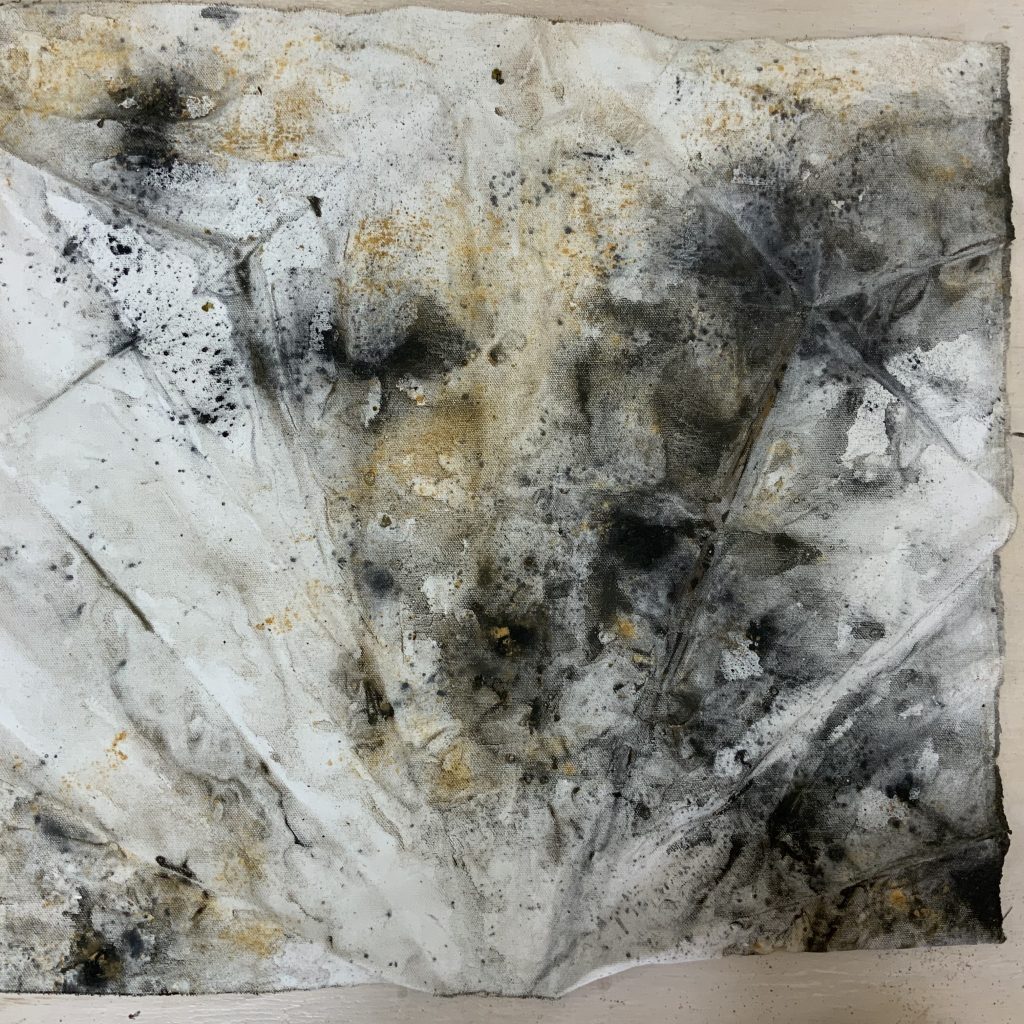
With the next canvasses I used the back side of the canvas. This is not gessoed and I wanted to see if the pigments will connect better with the canvas. The first canvas was dry, then folded after I added the charcoal and dipped open into a pool between rocks. The other two canvasses was first soaked in the waves, then I scrunched and folded one, then the oxide and charcoal was added to both. I dragged the canvasses in the sand as I took them to the waves, where I could submerge them into the sea. I stood on them to hold them down in the waves and keep them mostly flat as they enter the water. ( this is how I did my paper and charcoal paintings in Part Four)
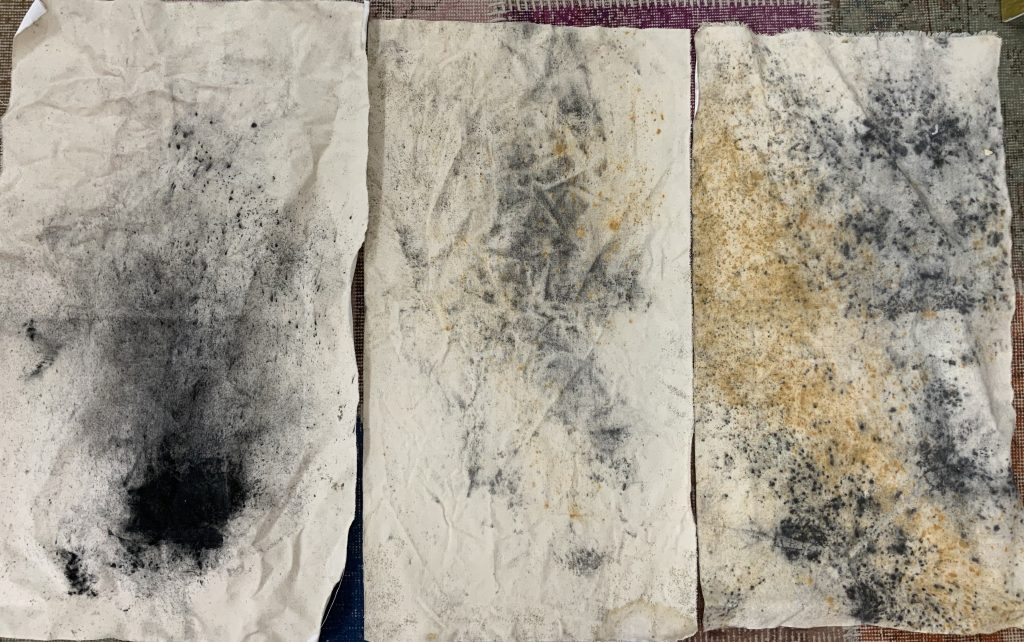
I feel even though I had limited control over the outcome of the work, I was realising my actions in the making can be described as manipulating: I did this with regards to the canvas, choosing the type of canvas onto which I will work (gessoed or ungessoed), by using a wet or dry canvas before putting the pigment on, by tightening it with rope changing the form of the canvas, or just merely holding it with my hands or standing on it, played a role in the forms or lines in the works that were created by its contact with the sea. I see this as learning by using making as research of my materials used. More ideas followed: I was working near a lot of lichens and instictively felt to explore their pigment. I picked some broken of branches with lichen on it and tried to crumble the lichen, which immediately showed a yellowish dye possibility. I feel this experience showed me how I can work with nature to manipulate these sea drawings. I read that the word, Ethnolichenology means the study of relationship between lichen and people. Lichens have been used for dying purposes in addition to it being used as medicine, as aromatice and food. It seems these yellow/orange lichens I collected are rich in gyrophoric acid


On SCRIBD I found a pdf on Botanical inks. I do like the following comment by the experienced writer and maker, Babs Behan of this book: ” It feels warming to the soul to know and feel that the materials you use to create beautiful things are in themselves full of beauty, safe to use and might even nourish the skin, body and wider environment.”
On Saturday 5 March 2022 I attended an Egg Tempera online session with OCA Tutor, Carolina Wright. I feel these materials I worked with connects me to the natural world and would like to explore how I can materialize ideas around mycelium, that known due to visual research, but also my subconscious ideas around this. I worked with Indigo and a Yellow Cement Oxide.

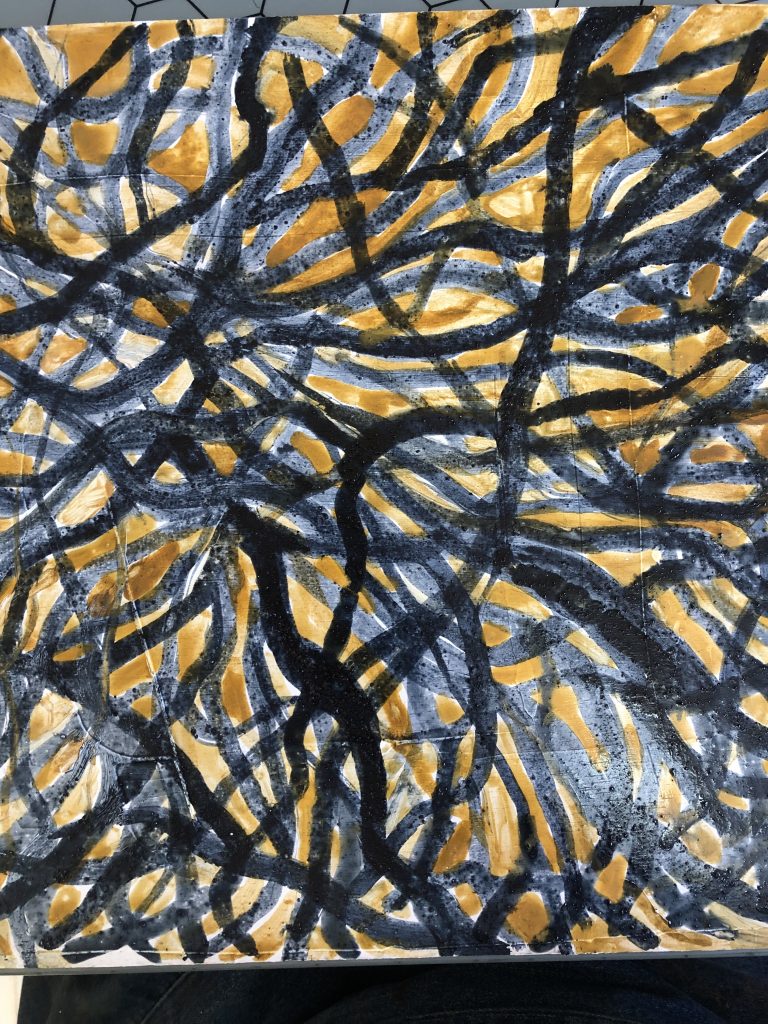
The outcome of the class for me was mainly around choices of materials I could use as pigments. I had samples of lichen, dried flowers, collected soil/sand, red wine, dried herbs to work and experiment with.
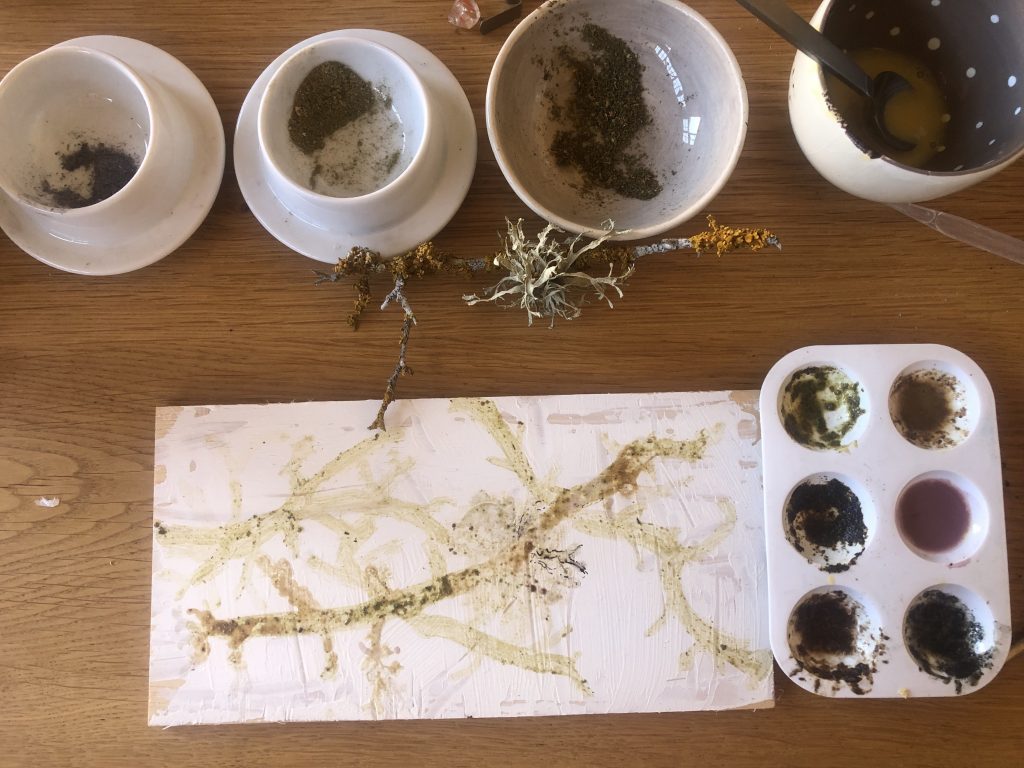
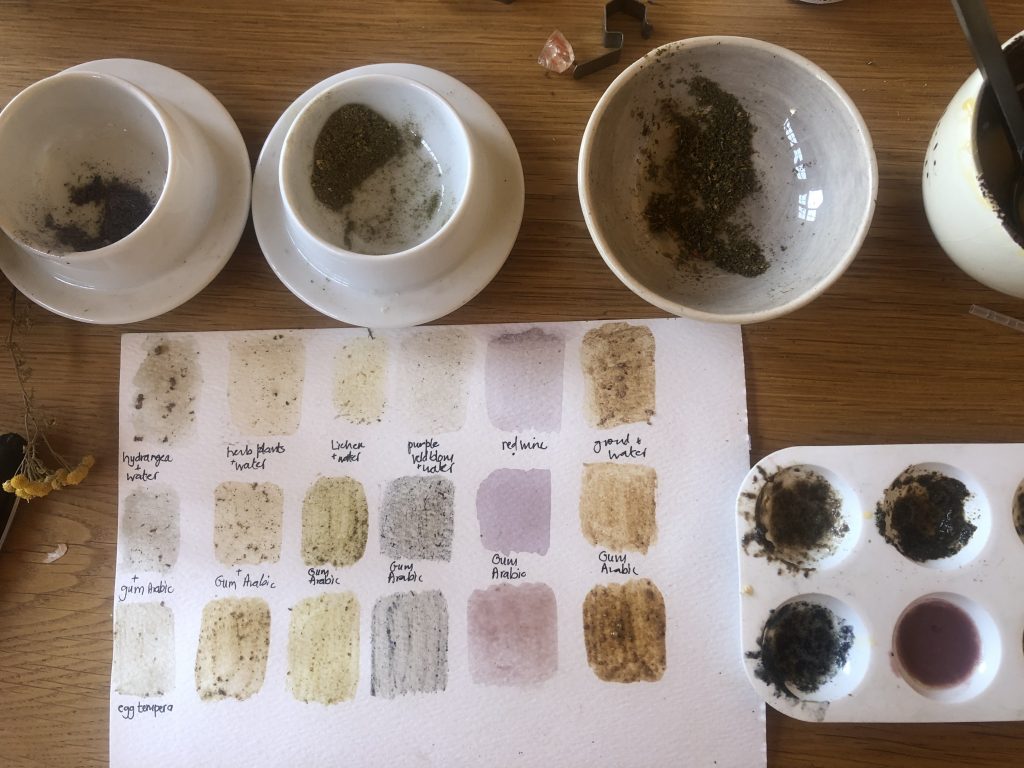
Criteria I would like to consider would be the following:
- Creative and/or intuitive use of materials – how I thought or imagined materials could be used and manipulated in my making – can one say that there is a type of knowing due to previous encounters or images I carry with me?
- understanding of the materials used – research of materials I used , skill, theory and reasoning
- knowledge acquired during the making- working with the materials, sensations of being with these materials and developing it further into finished work, mistakes, misshaps, lack of experience with making
- discus sources of contextual research – other artists, books, student groups, OCA online workshops
- use of reflection in my practice and study work(blog)
I also want to consider the ideas of Anish Kapoor in his making of Blood and Light. In this exhibition, 26 works are displayed in mostly red and black colours. The works are mostly done in steel, wood, resin, silicon, dye, water as well as oil. Some of the works are done on canvas support. I listened to a conversation with him at Lisson Gallery and inserted it here.
In the exhibition notes (online pdf) I read the following:
“Kapoor consistently engages with how painting
influences the way we perceive ourselves and our
surroundings. He experiments with the medium’s ability
to create visual effects and illusions, playing on the way
the eye perceives light, form and colour to address our
emotional, embodied experience as viewers of the work.
Kapoor’s latest works illuminate the power of painting,
evoking visual fictions created by pigments, waxes,
acrylics, oils, fabrics and frames.
His new paintings are gut-wrenching in their raw
vulnerability, their red tones suggesting intensely
affective landscapes that confront the subject of our
physical existence. Floor-based works are composed of
forms that suggest internal bodily organs, some brutally
hoisted onto metal tripods or framed within trays. But
even when enclosed within fixed boundaries, overflow
spouts give warning that the fresh bloody liquid may
overwhelm its containers.”
I came upon a PhDThesis which I thought to discuss and make notes around my learning. I would like to consider these ideas for my critical review.
Gazzard, Barry (1999) The significance of materials in modern painting [Doctor of Creative Arts dissertation] University of Wollongong. At: https://ro.uow.edu.au/cgi/viewcontent.cgi?article=1939&context=theses (Accessed on 16 February 2022)
Kapoor, Anish, 2021 In conversation with Julia Kresteva [facebook video]. https://anishkappor.com/7020/modern-art-oxford-2021-2022 (viewed on 18 February 2022)
De Freitas, Nancy, Towards a definition of studio documentation: working tool and transparent record
[pdf viewed Auckland University of Technology, NZ] Online at: https://www.herts.ac.uk/__data/assets/pdf_file/0011/12305/WPIAAD_vol2_freitas.pdf (viewed on 01/03/2022)
OR:
Contemplating the use of digital platforms by artists and their accessibility
To infinity and beyond: https://scholarship.shu.edu/cgi/viewcontent.cgi?referer=&httpsredir=1&article=1211&context=theses
Considering digital materials : I came upon an article called, Circumventing the white cube: DIGITAL CURATORIAL PRACTICES IN CONTEMPORARY MEDIA LANDSCAPES viewed online at: https://anti-materia.org/circumventing-the-white-cube (Accessed on 25 February 2022)
THE CUBE^3:
THREE CASE STUDIES OF CONTEMPORARY ART vs. THE WHITE CUBE
MARY CHAWAGA
Mary Rowe, Guardian Article :
Practice-based research ideas to read https://www.herts.ac.uk/__data/assets/pdf_file/0011/12305/WPIAAD_vol2_freitas.pdf